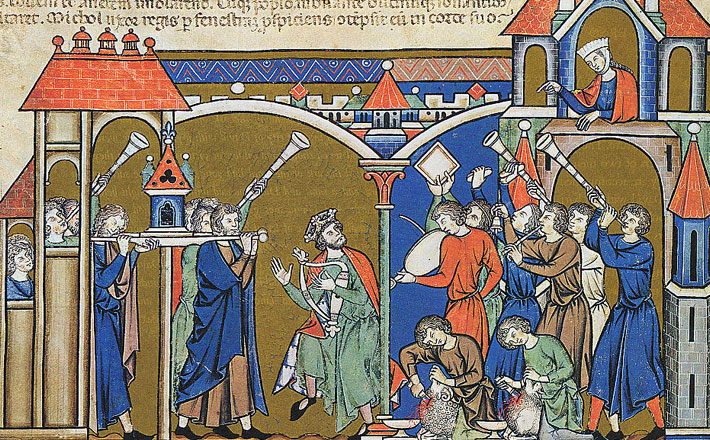Commentary on Psalm 107:1-3, 17-22
The texts for this Sunday provide the preacher with a whole kaleidoscope of themes and images.
We hear of snakes in the desert (Numbers 21, John 3:14), shipwrecks at sea (Psalm 107), and grace, faith, and good works (Ephesians 2). In the midst of all this is the most well-known verse in the Bible, John 3:16.
So what’s a preacher to do? Many will no doubt choose to tell the story of Nick at night and put John 3:16 in its full context (John 3:14-21). Our focus here, however, is on Psalm 107. The psalm itself concludes with an invitation to “consider” what it has to say — about God’s “steadfast love.” We shall begin by doing just that, and then try to bring the kaleidoscopic textual pieces together into a beautiful picture.
Psalm 107: some preliminaries
Psalm 107 begins with “O give thanks to the Lord for he is good” and ends with a directive to “consider the steadfast love of the LORD.” In between are four further references to God’s “steadfast love” (vv. 8, 15, 21, 31).
Psalm 107 fits the pattern of the hymn of praise, with a call to praise “O give thanks,” followed by reasons for praise “for he is good; for his steadfast love (Hebrew, hesed) endures forever” addressed to the congregation (v. 1; for an example of the two-part hymn of praise, see Psalm 113:1-3, 4-9). Four reports of God’s saving acts provide further reasons for praise (vv. 4-32) as does a reference to God’s activity of blessing (vv. 33-38).
The pattern of each report of God’s rescuing activity is the same:
1) a description of the people in trouble (vv. 4-5, 10-12, 17-18, 23-27),
2) a report that they prayed and God rescued them (vv. 6, 13-14, 19-20, 28-30),
3) a call to give thanks (vv. 8, 15-16, 21-22, 31-32).
Verse 43 sounds like a word from an editor/teacher, inviting participants to reflect on God’s steadfast love.
Hesed: the steadfast love of the Lord
Note the sense of hesed innon-theological contexts. David and Jonathan made a covenant with one another, sealing their friendship (1 Samuel 18:1-3). Jonathan asked David to remember him and his family, no matter what the future might bring, saying “If I am still alive, show me the faithful love (hesed) of the LORD … never cut off your faithful love (hesed) from my house …”(1 Samuel 20:14-15). The meaning of hesed in this context is loyal love between two parties who have made a formal pledge through a covenant (see also 1 Samuel 20:8). It is also part of the vocabulary for describing the loyal love between two parties in a marriage (Jeremiah 2:2, “devotion”; and Hosea 2:19, “steadfast love.”
The biblical book of Hosea is especially helpful for understanding the notion of hesed. The prophet uses his own marriage and divorce as an illustration. His wife had become unfaithful and he divorced her. But seeing her up for sale as a slave one day, he discovered he still loved her and bought her back (Hosea 1-3). The prophet’s story then became an illustration of the unfaithfulness of Israel to her God. The word hesed may be used to express God’s love for the people (Hosea 2:19). But it is also used to refer to the people’s lack of loyal love to God. Speaking in the name of God the prophet says to the people:
Your love (hesed) is like a morning cloud,
Like the dew that goes away early.
For I desire steadfast love (hesed) and not sacrifice,
The knowledge of God rather than burnt offerings.” (Hosea 6:4,6)
Thus hesed has the sense of loyal love between two parties bound by covenant.
Hesed: an illustration to make the point
An illustration: Ask the congregation or class to find Psalm 136 in the pew Bible or the hymnbook. Read the first half of each verse and ask the congregation to read the response for each, “for his steadfast love endures forever.” Ask the people, “What will you take home when you leave church today?” They will answer “for his steadfast love endures forever.” You then add, “And that’s worth remembering!” The Hebrew original is of course hesed.
John 3:16: write it on a postcard!
For some 16 years I taught Greek classes at a midwestern college. The students were mostly juniors, preparing for seminary study. One student had told me repeatedly how much he feared Greek. The course began and he seemed to be doing all right. I noticed that every so often he would look in the cover of his book, read something, and then return to whatever we were doing in class. When I asked him about it after class one day, he showed me. In his book he had pasted a post card from a friend. On it were the words from John 3:16. Then the friend had written: “If Jesus gave his life for you, you can book Greek for him!” The power of that Gospel word!
I always had our first year students memorize John 3:16 in Greek. There they encountered the New Testament Greek word, which is close to the “steadfast love” or hesed in the Old Testament. That word in Greek is agape, pronounced ah-gah-pay with the accent on the gah. The noun forms as well the verb are found all over the New Testament. John 3:16, for example, reads “For God so loved (a-gah-payed) the world that he gave … ”
The word agape is also found in the second lesson for this day, in both noun and verb forms. Ephesians 2:1-10 speaks of the “great love (agape) with which he loved (ah-gah-payed) us … ” (v. 4). The lesson as a whole is a commentary on the relationships between God’s grace (vv. 5,7,8) and the human response in faith (v. 8) all of which results in good works (v. 10).
Bringing these four kaleidoscopic texts together thus results in a picture of the steadfast love (hesed) with which God has loved (ah-gah-payed) us in Christ.


March 15, 2015